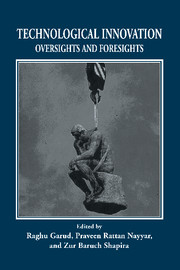Book contents
- Frontmatter
- Contents
- Contributors
- Foreword
- Preface
- Section I Introduction
- Section II Learning to flip coins
- Section III Tailoring fits
- Section IV Remembering to forget
- Section V (S)Top management and culture
- 13 Firm capabilities and managerial decision making: A theory of innovation biases
- 14 Organization responsiveness to environmental shock as an indicator of organizational foresight and oversight: The role of executive team characteristics and organizational context
- 15 Technological innovation, learning, and leadership
- 16 Risky lessons: Conditions for organizational learning
- 17 Exploiting enthusiasm: A case study of applied theories of innovation
- Section VI Clearing the fog
- Author Index
- Subject Index
14 - Organization responsiveness to environmental shock as an indicator of organizational foresight and oversight: The role of executive team characteristics and organizational context
Published online by Cambridge University Press: 07 October 2011
- Frontmatter
- Contents
- Contributors
- Foreword
- Preface
- Section I Introduction
- Section II Learning to flip coins
- Section III Tailoring fits
- Section IV Remembering to forget
- Section V (S)Top management and culture
- 13 Firm capabilities and managerial decision making: A theory of innovation biases
- 14 Organization responsiveness to environmental shock as an indicator of organizational foresight and oversight: The role of executive team characteristics and organizational context
- 15 Technological innovation, learning, and leadership
- 16 Risky lessons: Conditions for organizational learning
- 17 Exploiting enthusiasm: A case study of applied theories of innovation
- Section VI Clearing the fog
- Author Index
- Subject Index
Summary
Introduction
What makes firms successful over long periods of time? Many organizational theorists have argued that organizational environments evolve through long phases of incremental change, punctuated by radical transformations. Because changing environments can dramatically alter the basis of competitive success, organizations need to transform their mode of operation to enhance their prospects of future success. Change by itself, however, is not sufficient to deal with shifting criteria of market success: organizations have to change in a speedy manner in order to avoid losing their business to incumbent rivals or new entrants who are able to offer better, cheaper, or radically new products. If organizational decision makers cannot react with sufficient speed to new competitive challenges, attempts to align the organization with a changing environment may come too late and be entirely fruitless.
A large amount of empirical evidence has demonstrated the difficulty of firms to correctly foresee technological developments or even discern these shifts while they are occurring (Maclaurin, 1949; Tushman & Anderson, 1986; Henderson & Clark, 1990). As a result, the speed in which organizations adapt to major environmental changes can represent a crucial factor in reducing or amplifying the negative impact of a lack in technological foresight. The same is true for the case of technological oversights: the faster an Organization responsiveness to environmental shock 261 organization can correct its failure to ascertain shifts in the environment, the better are its chances to limit the damage such oversights can have on the future success of its business.
- Type
- Chapter
- Information
- Technological InnovationOversights and Foresights, pp. 260 - 278Publisher: Cambridge University PressPrint publication year: 1997
- 12
- Cited by

